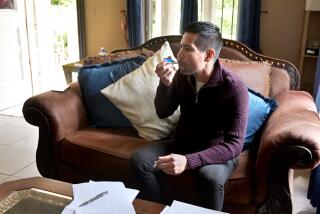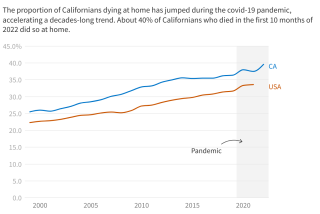House calls by doctors, revisited
All but extinct a couple of decades ago, the doctor house call has quietly reclaimed a small but important role in health care and appears poised to expand its popularity during the next several years.
The nation’s doctors made about 1.6 million visits to patients’ homes in 2001, an increase of about 100,000 from the previous year. In fact, physician house calls have topped the 1 million mark every year since the mid-1990s, according to government statistics. These doctor visits, paid for by Medicare, were made primarily to the homes of elderly patients who were unable to get to a physician’s office because of chronic illness.
For the record:
12:00 a.m. Nov. 11, 2002 For The Record
Los Angeles Times Monday November 11, 2002 Home Edition Health Part F Page 8 Features Desk 1 inches; 63 words Type of Material: Correction
Doctor’s name -- A story about doctor house calls in last Monday’s Health section misspelled the name of a Beverly Hills dermatologist. The correct spelling is Dr. David Amron, not Armon.
There’s another factor driving the popularity of house calls. Across the country, a number of private companies -- some founded by doctors -- are starting or expanding businesses to provide at-home medical care to patients. One such firm, AM-PM House Calls, operates in more than two dozen major cities, including Los Angeles, largely catering to more affluent city dwellers and travelers.
The rise in doctor house calls for Medicare recipients is related to the growing number of elderly Americans, many of whom are disabled or who have chronic problems that require frequent care. If such patients can’t get to a doctor their conditions may deteriorate, resulting in more intensive, and costlier, care later. If a patient with a chronic respiratory problem doesn’t get regular care, for example, the result may be an emergency -- transportation by ambulance, evaluation in the ER and overnight hospital stays, said Constance Row, executive director of the American Academy of Home Care Physicians, a nonprofit organization based in Edgewood, Md.
A much different reason for increased interest in house calls is the desire of more affluent Americans for care that offers convenience, privacy and the comfort of receiving medical attention in one’s own home.
“Who wants to wait six, seven, even eight hours in the ER for medical care?” said Dr. Peter Waldstein, a Beverly Hills pediatrician who is one of about 15 doctors involved in a start-up Los Angeles company called SOS MD4U. The firm expects to launch its 24-hour house call service in the next couple of months. The target patients: those who desire prompt medical attention but who are not critically ill, said Waldstein. He said a house call would cost $225; in contrast, his customary fee for an office visit is $75.
While Waldstein and his fellow doctors hope their new service will have broader appeal than just the highly affluent, other doctors are focusing their attention on celebrity clientele.
Dr. David Armon, a Beverly Hills dermatologist, provides in-home medical services for everything from a teenage acne outbreak to Botox treatment. His fee? Between $3,000 and $5,000 a visit. “Celebrities need to keep their privacy and beauty secrets intact,” said Armon. “The last thing my celebrity clients want the world to know is that they have had a mole removed, liposuction, Botox injections or a skin cancer scare.”
Health-care observers believe that the Medicare-related number of house calls will grow. That’s largely because the number of seniors is expected to double in the next 20 years, said Row, of the American Academy of Home Care Physicians. Today, the majority of Medicare payments for house calls goes toward treatment of the roughly 2 million Americans who are chronically housebound.
While the public may view house calls as an extravagance, Row makes the familiar point about an ounce of prevention being worth a pound of cure. “The system isn’t very good at handling chronic illnesses,” she said. “It adds to health-care costs, pain and suffering.”
One reason house calls all but disappeared by the mid-1970s was inefficiency. A doctor in an office can see 20 or more patients a day. A doctor making house calls would be hard-pressed to look in on half as many.
With this in mind, Medicare pays physicians more for a house call than an office visit: $182 for an office visit, on average, compared with $262 for a house call, according to national figures from the Centers for Medicare and Medicaid Services.
Private insurance coverage for house calls is murkier. Susan Pisano, a spokeswoman for the trade group American Assn. of Health Plans, said reimbursement would depend on several factors, including whether a doctor was part of the insurer’s physician network. “It’s like not you could just call a doctor for any old reason and say, ‘Be at my house at 5 o’clock,’ ” she said.
House call doctors say there is a lot they can handle with their black bag. “I’ve given everything from nebulizer treatments for asthma and stitched deep wounds,” said Dr. Dorsa Babai, who oversees AM-PM House Calls coverage of California. “I’ve even had a portable X-ray machine brought in.”
More to Read
Inside the business of entertainment
The Wide Shot brings you news, analysis and insights on everything from streaming wars to production — and what it all means for the future.
You may occasionally receive promotional content from the Los Angeles Times.










